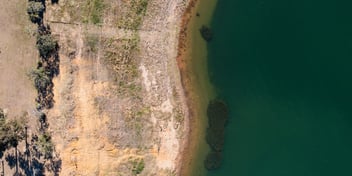How Western Water is building a resilient water supply network
In one of Australia’s fastest-growing regions, a Victorian water corporation is putting strategies in place to safeguard water resources.
Less than 20 years ago, Western Water supplied a number of small, outer suburban towns through conventional surface and groundwater sources.
Today, it provides water, recycled water and sewerage services to a population of about 160,000 people across 3000 square kilometres. These numbers are expected to increase as Melbourne continues to expand to the north and west, placing more demand on existing infrastructure.
“It’s a region of incredible change and growth,” Beca Business Director – Water Dan Stevens said during his poster pitch presentation at Ozwater’19.
“Over the next 20 years, the population of the area is expected to triple, which is a challenge for Western Water as an organisation and for the water supply.”
This isn’t the first time Western Water has had to adapt. During the Millennium Drought the utility was forced to make a number of changes, including getting bulk supply from Melbourne Water, developing recycled water plants, and investing in a more interconnected potable water transfer network.
Western Water now operates seven recycled water plants. These produce water to a Class A, B or C standard, which is supplied to customers through pipelines, standpipes and farm leases for various non-potable uses.
“The Millennium Drought put Western Water in a precarious situation that resulted in a number of actions,” Stevens said.
“And with climate change, it’s only going to get worse. This requires an integrated response.”
Different streams of action
Western Water’s approach to dealing with the competing pressures of a growing population and a changing climate is manifold, but its guiding principle is integrated water management.
This means taking a holistic view of the water cycle, including water, sewerage and recycled water services, rather than managing each system in isolation.
Taking the Victorian Government’s Water for Victoria initiative as a starting point, Western Water has developed a 50-year Urban Water Strategy (UWS) that includes three key goals:
- provide a safe and resilient water supply;
- maximise water use efficiency;
- and optimise the use of alternate water supplies.
“Western Water has embraced an integrated approach to water planning and management,” the UWS states.
“This approach not only looks at conventional water servicing to meet future community needs, but also considers alternate water options, such as optimising recycled water and stormwater to maintain water in landscapes, improve urban greening and to reduce waterway impacts.”
Feeding into this is Western Water’s Integrated Water Management Strategy, which identifies challenges and opportunities across the whole of water cycle to provide long-term servicing options.
“We hear a lot about integrated water management and the Sustainable Development Goals, and these ideas are really fundamental to the work Western Water is doing,” Stevens said.
“It’s about getting that balance between optimising water resources, promoting liveability and economic prosperity within the region, protecting waterways for the future, and looking at water reuse and recycled water.”
Master planning for the future
Western Water is also working with stakeholders including Melbourne Water, Southern Rural Water and the Victorian Department of Environment, Land, Water and Planning on a water grid expansion project.
This involves a water acquisition study, looking at where the utility can get water from; an e-flows study, which assesses the flows needed at different times of the year to promote healthy waterways; a transfer network master plan, which looks at how water moves around the network; and sub-regional water master plans.
“In Melton and Bacchus Marsh, we’ve got master plans at a sub-regional level that look at how individual growth areas are going to be fed, right up to a network master plan that brings everything together,” Stevens said.
“It’s an interconnected, region-wide view of the system and what it looks like into the future … We’re taking an adaptive planning approach. It’s about setting the general direction now and knowing that if things change, we can be nimble, adaptable and flexible in the future.”
To view all of our Ozwater'19 coverage, click here.

